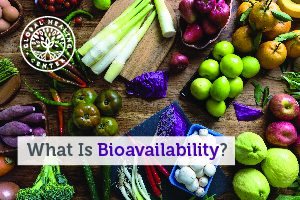The Efficient Absorption of Nutrients: What Is Bioavailability?
HEALTH, 6 Feb 2017
Dr. Edward Group | Global Healing Center – TRANSCEND Media Service
 Bioavailability is the proportion of a nutrient the human body is able to absorb and use. You might think that when you eat an apple every iota of vitamin A, every antioxidant, and every mineral it contains is used by your body with total efficiency, but that’s not exactly the case.[1]
Bioavailability is the proportion of a nutrient the human body is able to absorb and use. You might think that when you eat an apple every iota of vitamin A, every antioxidant, and every mineral it contains is used by your body with total efficiency, but that’s not exactly the case.[1]
Bioavailability and Nutrient Absorption in the Body
Digestion is the mechanism by which the human body processes the nutrients from food. Digestion is a complex sequence of events and small inefficiencies can lead to larger problems down the line. Enzymes, organ health status, and even how well you chew your food can affect digestive system efficiency. How well the digestive system operates can directly affect the bioavailability of the nutrients in food, and, in turn, affect important processes like enzyme production and organ function. It’s all interconnected.
Before the body can use a nutrient, it must separate that nutrient from the food it’s contained within. This process begins in the mouth with chewing and is assisted by the enzymatic action of saliva. It continues in the digestive tract where food is broken down into macronutrients and micronutrients. Nutrients are absorbed by the intestinal lining, transferred into the bloodstream, and distributed for use or storage.[2]
Macronutrients vs. Micronutrients
Nutrients can be separated into two basic categories—macronutrients and micronutrients. Macronutrients include carbohydrates, proteins, and dietary fats. They’re required in large amounts and necessary for tissue growth and providing the body with energy.[3] Macronutrients are highly bioavailable and may be up to 90% utilized.
Micronutrients include vitamins, minerals, antioxidants, and certain phytochemicals; examples include iron, iodine, vitamin A, and folate.[4] The bioavailability of micronutrients varies widely.[5] Though the body only needs them in trace amounts, they’re critical.[6, 7] Enzymes and hormones are responsible for the body’s most important processes. Imagine the negative health effects if micronutrients weren’t available to facilitate enzyme or hormone production.
Of all the micronutrient deficiencies, magnesium seems to be the most widespread. Magnesium deficiency has been linked to problems such as diabetes, hypertension, dementia, and osteoporosis.[8, 9, 10, 11]
Factors That Affect Bioavailability
Nutrient bioavailability may vary from one person to the next. Two different people can consume the exact same nutrient in the exact same form yet their bodies may absorb and use different quantities of that nutrient. There are a multitude of factors that influence individual absorption. In the case of vitamin B-12, if a person lacks intrinsic factor, a protein in the gut that helps the body absorb and use vitamin B-12, the vitamin will simply pass right through. Other factors that affect bioavailability include…
Digestive Disorders
Because bioavailability is heavily dependent upon the digestive process, a digestive system operating at less than optimal efficiency may not be, and probably isn’t, able to fully absorb and use all the nutrients it encounters. Nutrients in food may be absorbed at a rate as low as 20% or as high as 98%.[12] Crohn’s, IBS, and other inflammatory bowel conditions can severely impact the body’s ability to capture nutrients.
Age
Age is among the most influential factors that affect bioavailability.[13] Unfortunately, at least half of the children worldwide age 6 months to 5 years suffer from micronutrient deficiencies.[14] Without the right micronutrients in the right amounts, development can be affected and early infancy (0-6 months) and childhood (6-24 months) are two of the most critical periods of development. It’s one more reason to encourage breastfeeding; human breast milk is naturally rich in bioavailable nutrients.[15]
Supportive Nutrients
Some nutrients, when consumed together, support each other’s bioavailability. For example, calcium is best absorbed when it’s consumed alongside magnesium. Consuming vitamin C with plant-based, iron-rich food enhances the bioavailability of iron. This is why a varied, balanced diet is so beneficial; a variety of foods equates to a diverse selection of micronutrients that support and enhance each other.[16]
Orotates, which are highly bioavailable natural salts, were described in the 1970s by German researcher Hans Nieper. He recognized orotates as a component of a natural system of electrolyte carriers responsible for distributing minerals throughout the body.[17] Binding dietary minerals such as magnesium, zinc, potassium, lithium, and calcium to orotic acid can improve their bioavailability.[18]
Conversely, some micronutrient combinations interfere with each other. Tannins, which are polyphenols present in tea and wine, reduce the absorption of iron.[19] Found in nuts and seeds, phytic acid is an antinutrient that binds to nutrients and blocks absorption.
Why Is Bioavailability Important?
Bioavailability has an especially big impact on cellular metabolism. Your body has an incalculable number of cells and each of those cells is a living, breathing, functional organism with a metabolism and a purpose. Red blood cells have a different function than lung cells, which have a different function than brain cells. What all those cells have in common, however, is that they need the right nutrients in order to do their job.
Real Nutrition vs. Synthetic Nutrients
Whole, real, organic food is the best source of nutrition. A properly balanced diet should provide all the macronutrients and micronutrients the body requires. It sounds simple but it will require planning and won’t happen by accident. Sometimes, life gets in the way and rigorous adherence to a balanced diet isn’t completely achievable at all times. While they’re not a replacement for food, nutritional supplements can help fill the gap between the nutrients you consume and the nutrients your body needs.
The best nutritional supplements offer plant-sourced nutrients. There is a difference between the vitamins and minerals naturally found in an orange, and the vitamins and minerals synthetically produced in a lab and used to fortify cereal. I only recommend organic, food-sourced supplements made in the United States by reputable brands who are transparent about their methods and adhere to the highest industry standards.
The Secret To Health
To learn more about cultivating a clean, healthy body, check out The Secret to Health. Recorded live in Houston, it’s my seminar that teaches the importance of complete nutrition and how regularly cleansing your body can help you get the most nutritional value from your food.
Nutrient bioavailability is an important topic. If you have an experience that will add to the conversation, leave a comment below and share your story with us.
References (19)
†Results may vary. Information and statements made are for education purposes and are not intended to replace the advice of your doctor. Global Healing Center does not dispense medical advice, prescribe, or diagnose illness. The views and nutritional advice expressed by Global Healing Center are not intended to be a substitute for conventional medical service. If you have a severe medical condition or health concern, see your physician.
____________________________________
 Dr. Edward F. Group III, DC, NP, DACBN, DCBCN, DABFM has studied natural healing methods for over 20 years and now teaches individuals and practitioners all around the world. He no longer sees patients but solely concentrates on spreading the word of health and wellness to the global community. Under his leadership, Global Healing Center, Inc. has earned recognition as one of the largest alternative, natural and organic health resources on the Internet.
Dr. Edward F. Group III, DC, NP, DACBN, DCBCN, DABFM has studied natural healing methods for over 20 years and now teaches individuals and practitioners all around the world. He no longer sees patients but solely concentrates on spreading the word of health and wellness to the global community. Under his leadership, Global Healing Center, Inc. has earned recognition as one of the largest alternative, natural and organic health resources on the Internet.
Go to Original – globalhealingcenter.com
DISCLAIMER: The statements, views and opinions expressed in pieces republished here are solely those of the authors and do not necessarily represent those of TMS. In accordance with title 17 U.S.C. section 107, this material is distributed without profit to those who have expressed a prior interest in receiving the included information for research and educational purposes. TMS has no affiliation whatsoever with the originator of this article nor is TMS endorsed or sponsored by the originator. “GO TO ORIGINAL” links are provided as a convenience to our readers and allow for verification of authenticity. However, as originating pages are often updated by their originating host sites, the versions posted may not match the versions our readers view when clicking the “GO TO ORIGINAL” links. This site contains copyrighted material the use of which has not always been specifically authorized by the copyright owner. We are making such material available in our efforts to advance understanding of environmental, political, human rights, economic, democracy, scientific, and social justice issues, etc. We believe this constitutes a ‘fair use’ of any such copyrighted material as provided for in section 107 of the US Copyright Law. In accordance with Title 17 U.S.C. Section 107, the material on this site is distributed without profit to those who have expressed a prior interest in receiving the included information for research and educational purposes. For more information go to: http://www.law.cornell.edu/uscode/17/107.shtml. If you wish to use copyrighted material from this site for purposes of your own that go beyond ‘fair use’, you must obtain permission from the copyright owner.